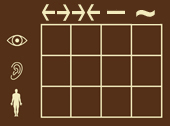 Derailing My Train of Thought, Thomas Wightman
Derailing My Train of Thought, Thomas Wightman
Papañca, the Thinking Mind Run Amok
by Ajahn Amaro, from "Thinking"
First, it isn’t the case that the mind is inherently thinking all the time. Rather, thinking is a highly conditioned activity. In the teachings, the process is described in this way: We come into contact with things—objects in the world or our own thoughts. Each moment of such contact is accompanied by feeling which is pleasant, painful, or neither. Whatever is being cognized is then named. The Pali word for this is sañña. Most often, it is translated as perception but the English word “sign” comes from the same root as sañña. Sañña is a kind of designation. There is a raw sensing of a stimulus and then our memory moves in and names it. “That is the sound of a dog barking.”
Conceptual thought begins to cluster around that naming. That is, that which we name, we then think about. This is called vitakka. We may think, “I wonder who owns that dog.” “Is that the same dog I saw yesterday?” Then vitakka takes off. It blossoms into what is known as papañca. This is conceptual proliferation. It is the mass of thoughts and conceptions, which burden the heart and mind.
In this process there is a simple raw feeling, sensation or thought. There is no particular feeling of self or other with that. But as the process takes off, as the naming takes place, we begin to get a sense of me in here experiencing the sound of that dog out there. As the thinking (vitakka) kicks in, the sense of self and other becomes more concrete and the sense of me not only experiencing this but also being burdened by it becomes more and more solid.
As meditators I am sure you have seen this pattern. With practice, we start to recognize this pattern. We see how it works.
Usually we are caught up in the activity of mental proliferation—half way through our great novel or fully through the saga of how our first marriage could have been “if only…”—before we wake up and remember that we’re actually still in the meditation hall, and that it all started with the sound of the dog barking. “That sound reminded me of Binker, our dog. We got the dog when we first got married. Maybe if we hadn’t had the dog, the marriage would have worked out.” Then we track it back and see where it began.
As meditators we see how this pattern occurs over and over again. The mind’s propensity is to think habitually. It takes almost nothing to trigger it. For example, I spent most of my youth listening to rock music at every opportunity. So when I entered the monastery in Thailand, I spent the first few years singing inside my head. My mind was so used to listening to music that for the first few years everything that happened at the monastery was a cue for a song. It could be a leaf falling off a tree or a car going by. It could be the clanking of a kerosene tin or comments that people made. It could even be just the random thoughts in my mind. Any one event, word or thought could translate into a lyric. It was like a Bing Crosby and Bob Hope movie: “That sounds like a cue for a song...” Before you know it you are playing the entire soundtrack. I was staggered by the amount that the mind remembered and conjured up!
That is the mind’s habitual mode. It picks things up, chews on them and keeps creating—all from a moment’s stimulation...
So for myself, I have learned that the best way to deal with excessive thinking is to just listen to it, to listen to the mind. Listening is much more effective than trying to stop thought or cut it off. When we listen there is a different mode employed in the heart. Instead of trying to cut it off, we receive thought without making anything out of it.
 Plagued by Doubt, Thomas Wightman
Plagued by Doubt, Thomas Wightman
See also:
Amaro, A. (July 20, 2010). Thinking: I. Understanding and relating to thought. Mindfulness, 1, 3, 189-192. Retrieved from Springer Link.
The Medium is the Message by Thomas Wightman
 Sunday, April 13, 2014 at 09:04AM
Sunday, April 13, 2014 at 09:04AM  Andrew Telling,
Andrew Telling,  Chloe Early,
Chloe Early,  art,
art,  color,
color,  flow,
flow,  impermanence,
impermanence,  meditation,
meditation,  seeing
seeing 











